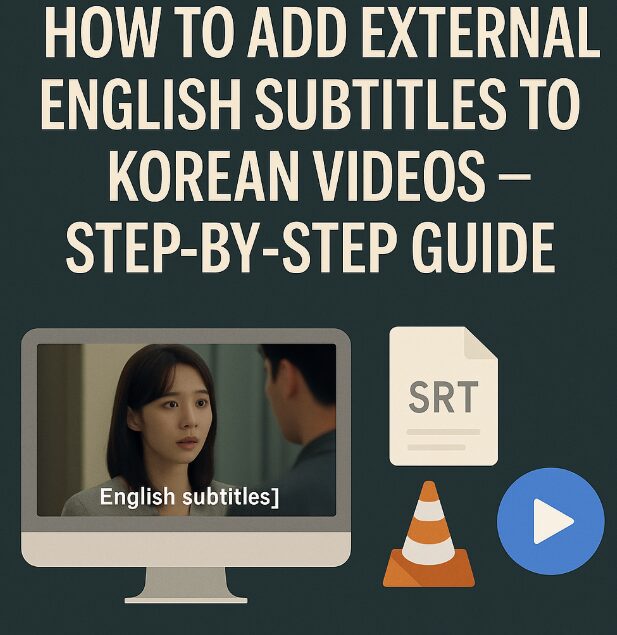If you’re a fan of Korean dramas, movies, or variety shows but often find that your favorite titles don’t include English subtitles, you’re not alone. While platforms like Netflix or Viki usually offer subtitles, many Korean videos from fan uploads or unofficial sources require a little DIY effort. In this post, you’ll learn how to download external subtitle files and sync them with your Korean videos using tools like VLC and MX Player.
Whether you’re learning Korean or simply want to enjoy K-content without missing any dialogue, here’s a detailed step-by-step guide.

What Are External Subtitles and Why Should You Use Them
External subtitles are files that display text alongside a video but are not embedded within the video file itself. These subtitles are usually in .srt, .ass, or .sub format and can be loaded manually into video players.
Benefits of using external subtitles include:
The ability to choose or customize translations
Sync adjustments for out-of-sync subtitle files
Compatibility with different media players
Use for language learning, especially with dual language subs
Where to Download English Subtitles for Korean Content
Several trusted subtitle websites offer English subs for Korean dramas, movies, and TV shows. Always ensure the subtitle file matches the video version (resolution, source, episode, etc.).
Here are some of the best subtitle download sites:
Subscene – Reliable and regularly updated, with filtering by language
OpenSubtitles – Extensive database, though it includes many ads
KSubtitles – Focused specifically on Korean content
Addic7ed – Great for series, especially newer ones
Make sure you download the correct subtitle version that matches the runtime and format of your video (e.g., WEB-DL, HDTV, 1080p).
Match Your Subtitle File with the Video File
For automatic loading in most media players, the subtitle file name should exactly match the video file name.
Example:
Video file:
QueenOfTears_Ep01.mp4Subtitle file:
QueenOfTears_Ep01.srt
Both files should be placed in the same folder. This small step ensures that your media player automatically recognizes the subtitle file.
How to Use VLC Player to Add and Sync Subtitles (Desktop)
VLC Media Player is one of the most popular free video players available. It works on Windows, macOS, and Linux, and fully supports external subtitles.
Steps to add subtitles in VLC:
Open your video in VLC
From the top menu, select Subtitle > Add Subtitle File
Choose the
.srtfile you downloaded
To fix subtitle timing if it’s not in sync:
Press
Hto delay orGto advance the subtitle by 50ms incrementsOr go to Tools > Track Synchronization for more precise control
You can also adjust subtitle font size, position, and encoding under Tools > Preferences > Subtitles / OSD.
How to Use MX Player for Subtitles on Android
If you’re watching on an Android phone or tablet, MX Player is a great option with built-in support for external subtitles.
Steps to add subtitles in MX Player:
Store both video and
.srtfile on your deviceOpen the video in MX Player
Tap the three-dot menu at the top-right corner
Select Subtitle > Open, then pick your subtitle file
You can also adjust subtitle timing via Subtitle > Synchronize, and customize appearance (font size, color, position) in settings.
Common Subtitle Sync Problems and How to Fix Them
Sometimes subtitles don’t align with the audio. Here’s how to troubleshoot:
Wrong subtitle version – Download another version or try one made for the same release group
Frame rate mismatch – If your video is 24fps but the subtitle was made for 30fps, syncing will drift over time
Delay or early start – Use VLC’s sync tools or MX Player’s synchronization feature
Edit subtitles manually – Use tools like Subtitle Edit to adjust subtitle timings yourself
How to Burn Subtitles into the Video Permanently (Optional)
If you want to share the video or watch it on a device that doesn’t support external subs, you can “burn in” the subtitles.
Use a free tool like HandBrake:
Install and open HandBrake
Load your video file
Go to the Subtitles tab → click Import SRT
Check Burn In to permanently embed the subtitle
Set the output format (e.g. MP4) and start encoding
This process creates a new video file with subtitles permanently visible.
Tips for Korean Language Learners Using Subtitles
If you’re learning Korean, subtitles can be an amazing resource. Try this three-pass method:
Watch with English subtitles
Watch again with Korean subtitles (if available)
Finally, watch without any subtitles
You can use VLC’s hotkeys or plugins to easily switch subtitle tracks. For browser-based content, consider using Language Reactor for dual subtitles and pausing with word-by-word translation.
Where to Find Korean Videos Compatible with External Subtitles
You’ll need videos that allow manual subtitle loading. Here are common sources (make sure they are legal in your region):
Torrent sites like 1337x or RARBG – Use a VPN and check your local laws
Reddit communities like r/KDRAMA
Telegram or Discord subtitle-sharing groups
Archive platforms and private fan servers
Korean broadcasters’ websites for raw files (no subtitles included)
If possible, support official streaming platforms to help creators continue producing great content.
Subtitle Setup Opens Up a World of Korean Content
Being able to manually add English subtitles gives you full control over how and when you enjoy Korean content. You’re no longer limited to platforms with limited libraries or delayed translations.
With just a subtitle file, a video player, and a bit of matching effort, you can enjoy everything from indie Korean films to classic K-dramas and hidden YouTube gems.
Whether you’re a casual viewer, a K-pop fan, or a language learner, this skill will unlock a whole new level of access to Korean media.